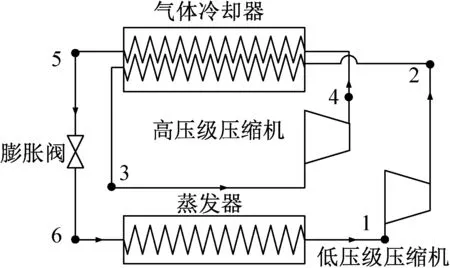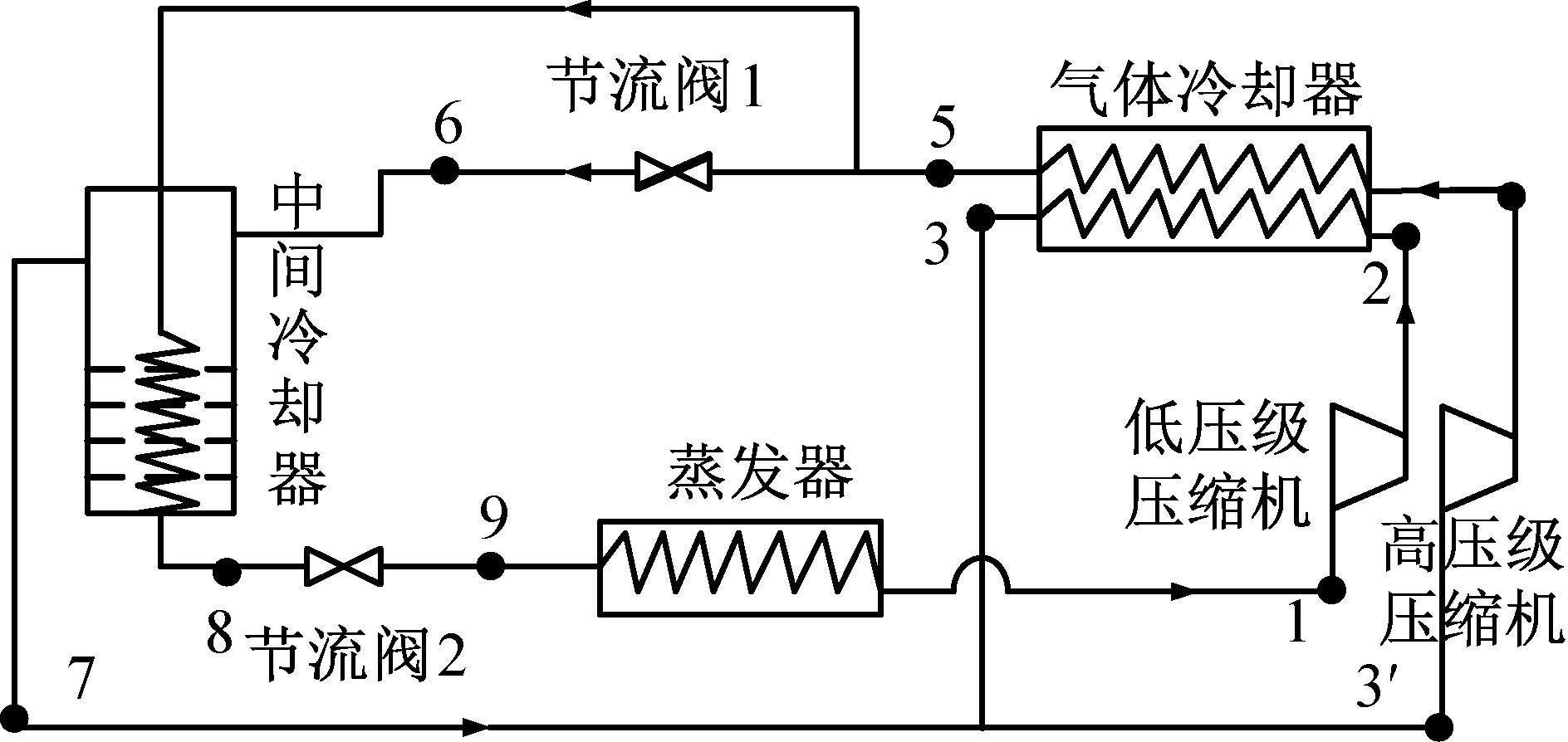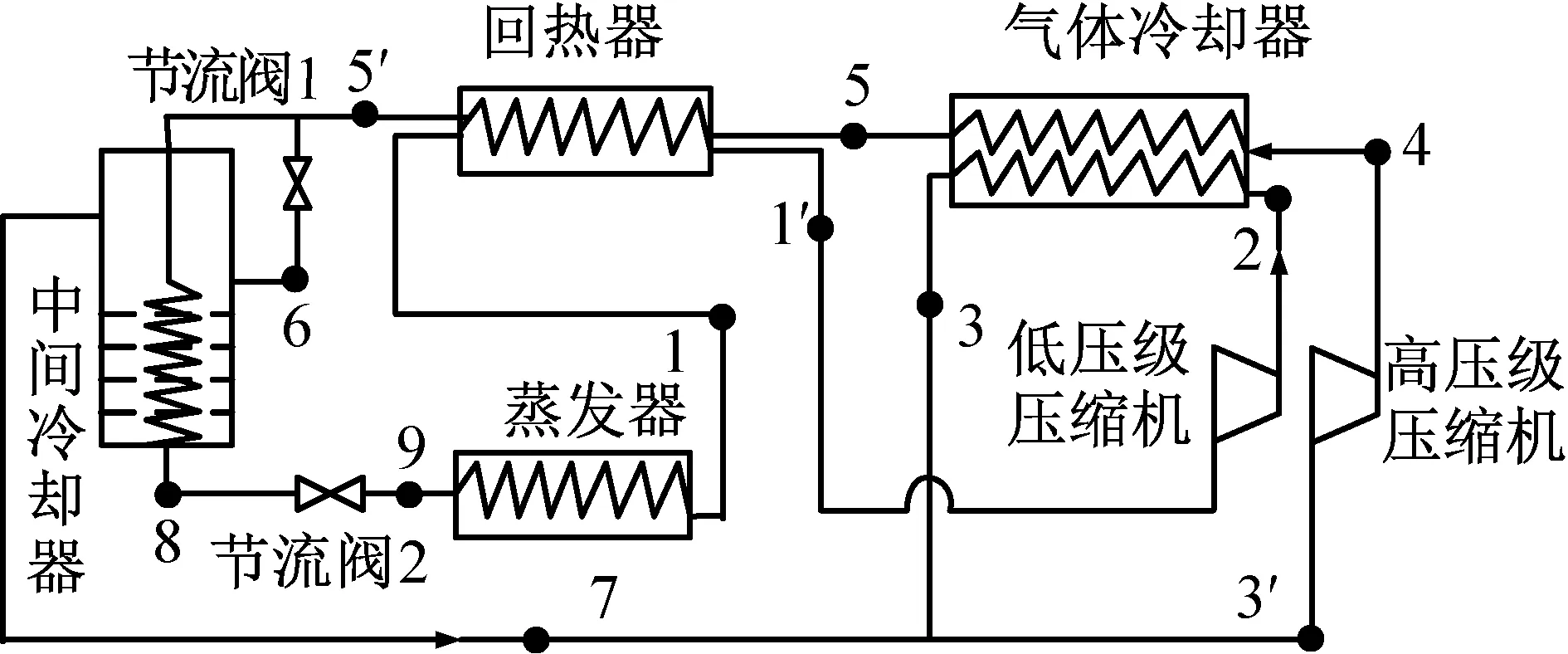单级跨临界二氧化碳带膨胀机循环与四种双级循环的热力学分析
2016-09-07孙志利马一太
孙志利 马一太
(1 天津商业大学 天津市制冷技术重点实验室 天津 300134;2 天津大学热能研究所 天津 300072)
单级跨临界二氧化碳带膨胀机循环与四种双级循环的热力学分析
孙志利1马一太2
(1 天津商业大学 天津市制冷技术重点实验室天津300134;2 天津大学热能研究所天津300072)
本文对制冷工况下,单级跨临界二氧化碳(CO2)带膨胀机循环、跨临界CO2双级压缩无回热器循环、跨临界CO2双级压缩加回热器循环、跨临界CO2双级压缩一级节流无回热器循环和跨临界CO2双级压缩一级节流加回热器循环五种循环的性能进行了分析比较。结果表明:当膨胀机的效率为60%时,在所规定的蒸发温度范围内(-10~20 ℃),单级跨临界CO2带膨胀机循环的性能要高于其它四种双级压缩循环。当蒸发温度为5 ℃时,只要膨胀机的效率大于32%,单级压缩膨胀机循环的性能就高于其它四种双级压缩循环。对于四种双级压缩循环,前两种循环适用于中高温制冷,且回热循环性能较好;后两种带中间冷却器的循环适宜于中低温制冷,增加回热器后性能反而下降。
膨胀机;CO2;跨临界循环;双级;单级
跨临界二氧化碳(CO2)制冷循环的特点是操作压力较高,压差较大,并且存在很大的节流损失,因此系统的效率非常低。近年来,国内外许多研究者都对如何提高CO2跨临界循环系统的效率提出了多种改进措施[1-5]。比如:在系统中加回热器;用膨胀机代替节流阀;双级压缩循环等。Robinson D M[6]分别对带膨胀机和回热器的CO2跨临界循环进行了理论分析,发现使用膨胀机回收膨胀功可减小35%的不可逆损失,并且用膨胀机代替节流阀与回热器循环相比,可使系统的COP增加25%,但是使用膨胀机再加回热器后反而使系统COP降低8%。文献[7]也表明,只要膨胀机的等熵效率大于11%,带膨胀机系统的性能就优于回热循环。Huff Hans-Joachim等[8]对三种不同形式的CO2跨临界双级压缩循环进行了研究,比如闪蒸循环,相分离循环以及分流循环。结果表明:分流循环的性能最好,比基本单级循环提高了38%~63%。但是如果考虑到成本、所占空间以及设备重量等因素,简单的双级压缩加中间冷却并带回热器循环可能更占优势。Inagaki M等[9]用实验研究了CO2空调系统分流循环的性能。在中等室外温度下,COP提高20%,制冷量提高35%;在较高的室外温度下,COP提高5%,制冷量提高10%。
1 单级跨临界CO2带膨胀机循环
在制冷系统中,减少节流损失、提高COP的最直接方法是膨胀功回收。对于CO2跨临界循环来说,由于其膨胀比为24,膨胀功占压缩功的比例较大(20%~25%),因此,从理论上用膨胀机代替节流装置是可行的。带膨胀机的CO2跨临界循环工作原理如图1所示,图2所示为相应的热力学循环T-s图。带膨胀机循环和一般循环的主要区别在于用膨胀机代替了原来的节流阀。

图1 单级跨临界CO2带膨胀机循环原理图Fig.1 The principle diagram of single stage transcritical CO2 cycle with expander

图2 单级跨临界CO2带膨胀机循环T-s图Fig.2 The T-s diagram of single stage transcritical CO2 cycle with expander
2 跨临界CO2双级压缩循环
双级压缩循环是改善CO2跨临界循环,减少节流损失,提高系统性能系数的另一种途径。双级压缩循环通常有多种结构形式。
2.1 跨临界CO2双级压缩无回热器循环
跨临界CO2双级压缩无回热器循环,包括低压压缩机、高压压缩机、气体冷却器、节流阀和蒸发器。图3所示为循环原理图,图4所示为相应的热力学循环T-s图。CO2双级压缩循环也存在最优中间压力,对应着最大COP。为了简化气体冷却器的设计,可通过调节中间压力使得两台压缩机的排气温度相等,即T2=T4。

图3 跨临界CO2双级压缩循环原理图Fig.3 The principle diagram of transcritical CO2 two-stage cycle

图4 跨临界CO2双级压缩循环T-s图Fig.4 The T-s diagram of transcritical CO2 two-stage cycle
2.2 跨临界CO2双级压缩加回热器循环
双级压缩也可以增加回热器,能够降低节流前制冷剂的温度。但是过热度不能取得过大,应该根据实际需要选择合适的过热度。CO2跨临界双级压缩回热循环的工作原理如图5所示,其相应的T-s图如图6所示。从气体冷却器出来的CO2气体经过回热器降温(6-7),经节流阀节流到蒸发压力后进入蒸发器(7-8),在蒸发器中蒸发吸热(8-1),进入回热器被加热后(1-2),再进入低压级压缩机压缩至中压(2-3),中压排气经气体冷却器冷却后成为高压压缩机的吸气(3-4),被高压压缩机压缩至高压后(4-5),排入气体冷却器冷却(5-6),完成一个循环过程。

图5 跨临界CO2双级压缩回热循环原理图Fig.5 The principle diagram of transcritical CO2 two-stage cycle with intermediate heat exchanger

图6 跨临界CO2双级压缩回热循环T-s图Fig.6 The T-s diagram of transcritical CO2 two-stage cycle with intermediate heat exchanger
2.3 跨临界CO2双级压缩一级节流循环
降低节流前温度,减少节流损失也可以通过双级压缩一级节流循环来实现,系统工作原理如图7所示。从气体冷却器出来后的流体进行分股,其中一股经节流阀1节流降温后进一步冷却另一股高压流体,这股高压流体被冷却后进入节流阀2节流降温,再进入蒸发器。当然,在双级压缩一级节流循环中也可以增设回热器,系统工作原理如图8所示,它们相应的T-s图分别如图9和图10所示。
3 计算模型[10-17]
3.1 单级压缩跨临界CO2带膨胀机循环
1)单位制冷量:
qo=h1-h4
(1)
2)压缩机耗功:
w=(h2-h1)-(h3-h4)
(2)
3)系统性能系数:
(3)

图7 跨临界CO2双级压缩一级节流无回热器循环原理图Fig.7 The principle diagram of transcritical CO2 two-stage & primary throttling cycle without intermediate heat exchanger

图8 跨临界CO2双级压缩一级节流加回热器循环原理图Fig.8 The principle diagram of transcritical CO2 two-stage & primary throttling cycle with intermediate heat exchanger

图9 双级压缩一级节流循环T-s图Fig.9 The T-s diagram of the two-stage compression of first level throttling system

图10 双级压缩一级节流回热循环T-s图Fig.10 The T-s diagram of two-stage compression of first level throttling system with intermediate heat exchanger
3.2 跨临界CO2双级压缩循环
1) 单位制冷量:
qo=h1-h6
(4)
2) 压缩机耗功:
w=(h2-h1)+(h4-h3)
(5)
3) 系统性能系数:
(6)
3.3 跨临界CO2双级压缩加回热器循环
1) 单位制冷量:
qo=h1-h8
(7)
2) 压缩机耗功:
w=(h3-h2)+(h5-h4)
(8)
3) 系统性能系数:
(9)
4) 回热器热平衡:
h2-h1=(h6-h7)×0.9
(10)
3.4 跨临界CO2双级压缩一级节流循环
设流经高压级压缩机的流量为mh,低压级压缩机的流量为ml。
1) 制冷量:
Qo=ml×(h1-h9)
(11)
2) 压缩机耗功:
W=ml×(h2-h1)+mh×(h4-h3)
(12)
3) 中间冷却器热平衡:
ml(h5-h8)=(mh-ml)×(h7-h6)
式中:h5=h6, 可得:
(13)
4) h3的计算(根据绝热混合计算):
(14)
5) 系统性能系数:
(15)
(16)
3.5 跨临界CO2双级压缩一级节流加回热器循环
设流经高压级压缩机的流量为mh,低压级压缩机的流量为ml。
1) 制冷量:
Qo=ml×(h1-h9)
(17)
2) 压缩机耗功:
W=ml×(h2-h1′)+mh×(h4-h3)
(18)
3) 中间冷却器热平衡:
ml(h5-h8)=(mh-ml)×(h7-h6)

(19)
4) h3的计算(根据绝热混合计算):
(20)
5) 回热器热平衡:
h1′-h1=(h5′-h5)×0.9
(21)
6) 系统性能系数:
(22)
(23)
4 结果与分析
4.1 模拟条件
本文采用MATLAB调用Refprop数据进行模拟分析,为了简化模型的计算,给出以下假设:1)系统在稳态条件下运行,忽略换热器及其它管道的压降和热损失;2)高压侧排气压力设定为10 MPa;3)压缩机的效率取为70%;4)膨胀机效率设为0%~100%;5)蒸发温度取为-10~20 ℃;6)气体冷却器出口温度取40 ℃;7)过热度取为1~25 ℃;8)回热器的效率取为0.9;9)高压流体通过中间冷却器盘管后的温度比中间温度高5 ℃。
4.2 模拟结果

从表1的计算结果可以看出,满足排气温度相等时所得到的COP非常接近最佳COP,而用几何平均值所求得的COP最低。满足最佳COP时所得到的中间压力最高,用几何平均值所求得的中间压力最低。就排气温度来说,几何平均值所求得的高压级排气温度最高,满足最佳COP时的高压级排气温度最低;对低压级排气温度两种方法正好换位;第三种方法的计算结果介于两者之间。

表1 三种中间压力计算方法性能比较
注:1表示最佳COP所对应的中间压力;2表示几何平均值;3表示满足排气温度相等。
特别值得一提的是,对于跨临界CO2双级压缩一级节流及其回热制冷循环,通过计算发现,由于条件限制,系统满足不了高低压级压缩机排气温度相等这一条件,并且当蒸发温度高于5 ℃时,中间压力的调节范围很小;而在中低温制冷时,中间压力的调节范围较大。计算这两种循环时,中间压力取高低压压力的几何平均值。
图11给出了上述五种制冷循环的性能比较结果。计算条件设为:蒸发温度为-10~20 ℃,过热度取10 ℃,膨胀机效率取为60%。从图11可以看出,当膨胀机的效率达到60%时,膨胀机循环的性能系数高于其它四种循环。当蒸发温度高于5 ℃左右时,双级回热循环的COP高于其它三种循环;而当蒸发温度较低时(低于5 ℃),双级节流循环的性能高于双级压缩及其回热循环,这说明双级节流循环适于在中低温制冷时应用。从图中还可以发现,在跨临界CO2双级压缩一级节流及其回热制冷循环中,增加回热器后性能系数反而降低。这说明在低温制冷情况下,设置回热器而增加的部分冷量小于压缩机吸气过热而导致的压缩功增量,因此在中低温制冷时,不必增加回热器,从图12也可以看出类似的规律。计算条件为蒸发温度为5 ℃。在跨临界CO2双级压缩中,性能系数随过热度的增加而增大;而在跨临界CO2双级压缩一级节流回热制冷循环中,随过热度的增大,系统COP呈下降趋势。

图11 五种制冷循环COP随蒸发温度的变化Fig.11 The variation of COP of five kinds of refrigeration cycle with the change of evaporation temperature

图12 两个双级回热循环COP随过热度的变化Fig.12 The variation of COP of two double stage heat cycles with the change of superheat
图13给出了在不同的膨胀机效率下,膨胀机循环与其它循环的性能比较。计算条件为:蒸发温度为5 ℃,过热度为10 ℃。从图中可以看出,只要膨胀机的效率大于32%,膨胀机循环的性能就高于其它四种循环。

图13 不同膨胀机效率下的性能比较Fig.13 Performance comparison of different expansion machines
图14所示为五种循环的压缩机排气温度随蒸发温度的变化。计算条件为:蒸发温度为-10~20 ℃,过热度取10 ℃,膨胀机效率取60%。从图中可以看出,蒸发温度较低时,膨胀机循环的排气温度较高,随着蒸发温度的增加,双级节流回热循环的高压级压缩机排气温度最高;而双级循环高压级压缩机的排气温度最低,其次是双级回热循环和双级节流循环。

图14 压缩机排气温度随蒸发温度的变化Fig.14 Variation of exhaust temperature of the compressor with the change of evaporation temperature
5 结论
本文对单级跨临界CO2带膨胀机循环、跨临界CO2双级压缩无回热器循环、跨临界CO2双级压缩加回热器循环、跨临界CO2双级压缩一级节流无回热器循环和跨临界CO2双级压缩一级节流加回热器循环五种循环的性能进行了热力学分析比较,得到以下结论:
1)当膨胀机的效率为60%时,在所规定的蒸发温度范围内(-10~20 ℃),单级跨临界CO2带膨胀机循环的性能就高于其它四种双级压缩循环。当蒸发温度为5 ℃时,只要膨胀机的效率大于32%,单级压缩膨胀机循环的性能就高于其它四种循环。
2)利用膨胀机回收膨胀功是提高CO2跨临界制冷循环系统效率的根本途径。对于其它四种双级压缩制冷循环,前两种循环适宜于中高温制冷条件,而且回热循环性能较好;后两种带中间冷却器的循环适宜于中低温制冷,但增加回热器后性能反而下降。
3)虽然采用膨胀机代替节流阀,可以最大程度的减少节流损失,但技术难度较大,成本较高。膨胀机的结构和优化设计应该适应CO2跨临界两相流动的要求,同时还要解决膨胀机和压缩机的连接以及膨胀功的回收方式等问题。双级压缩循环不但能够降低节流阀前的入口焓,即降低入口温度,而且能够降低压缩机的排气温度,减小压缩功,在技术上也能够达到。在实际应用时,应该综合考虑各方面的因素,适当选用不同循环形式。
[1]Lorentzen G, Pettersen J. New possibilities for non-CFC refrigeration[C] // IIR International Symposium on Refrigeration, Energy and Environment. Norway, 1992: 147-163.
[2]Lorentzen G. The use of natural refrigerants: a complete solution to the CFC/HCFC predicament [J]. International Journal of Refrigeration, 1995, 18(3): 190-197.
[3]Pramote L, Jirawan T, Tanongkiat K, et al. Theoretical performance analysis of heat pump water heaters using carbon dioxide as refrigerant[J]. International Journal of Energy Research, 2008, 32(4): 356-366.
[4]Hwang Y, Radermacher R. Carbon dioxide refrigeration system[R]. Maryland: University of Maryland, 1998.
[5]Kim S G, Kim Y J, Lee G, et al. The performance of a transcritical CO2cycle with an internal heat exchanger for hot water heating[J]. International Journal of Refrigeration, 2005, 28(7): 1064-1072.
[6]Robinson D M, Groll E A. Efficiencies of transcritical CO2cycles with and without an expansion turbine[J]. International Journal of Refrigeration, 1998, 21(7): 577-589.
[7]查世彤. 二氧化碳跨临界循环膨胀机的研究与开发[D]. 天津: 天津大学, 2002.
[8]Huff Hans-Joachim, Hwang Y, Radermacher R. Options for a two-stage transcritical carbon dioxide cycle [C] // 5th IIR-Gustav Lorentzen Conference on Natural Working fluids, Guangzhou, China, 2002: 143-149.
[9]Inagaki M, Sasaya H, Ozakli Y. Pointing to the future: two-stage CO2: compression[C]//Presented at International Conference on Heat Transfer Issues in ‘Natural’ Refrigerants. College Park, MD, 1997.
[10] Yang J L, Ma Y T, Li M X, et al. Exergy analysis of transcritical carbon dioxide refrigeration cycle with an expander [J]. Energy, 2005, 30(7):1162-1175.
[11] Sarkar J, Agrawal N. Performance optimization of transcritical CO2cycle with parallel compression economization [J]. International Journal of Thermal Sciences, 2010, 49(5): 838-843.
[12] 姜云涛, 马一太, 李敏霞, 等. 二氧化碳跨临界循环系统用新型膨胀机的研发[J]. 制冷学报, 2010, 31(5): 1-4.(JIANG Yuntao, MA Yitai, LI Minxia, et al. Development of newly-designed expander used in CO2trans-critical system [J].Journal of Refrigeration, 2010, 31(5): 1-4.)
[13] 马一太, 李敏霞, 李丽新,等. CO2跨临界膨胀机的开发与实验研究[J]. 制冷学报, 2003, 24(4): 5-9.(MA Yitai, LI Minxia, LI Lixin ,et al. Development and experimental research on CO2transcritical expander[J]. Journal of Refrigeration, 2003, 24(4): 5-9.)
[14] 张国庆, 傅李鹏, 吴忠杰, 等. 环境友好型跨临界CO2制冷工质的应用与研究进展[J]. 材料研究与应用, 2008, 2(4): 395-399.(ZHANG Guoqing, FU Lipeng, WU Zhongjie,et al. Application and research progress of environment friendly CO2trans-critical refrigeration engineering[J]. Materials Research and Application, 2008, 2(4): 395-399.)
[15] 张会勇, 李俊明, 王补宣. 过热度和高压压力对跨临界CO2汽车空调系统的影响[J]. 清华大学学报(自然科学版), 2005, 45(11): 1573-1576.(ZHANG Huiyong, LI Junming, WANG Buxuan. Effects of superheat temperature and high pressure on transcritical automobile air conditioning systems using carbon dioxide as refrigerant[J]. Journal of Tsinghua University(Science and Technology), 2005, 45(11): 1573-1576.)
[16] 黄冬平, 丁国良, 张春路. 不同跨临界二氧化碳制冷循环的性能比较[J]. 上海交通大学学报, 2003, 37(7):1094-1097.(HUANG Dongping, DING Guoliang, ZHANG Chunlu. Performance comparison of varied transcritical carbon dioxide refrigerating cycle [J]. Journal of Shanghai Jiao Tong University, 2003, 37(7): 1094-1097.)
[17] 姜云涛. CO2跨临界水-水热泵及两缸滚动活塞膨胀机的研究[D]. 天津: 天津大学, 2009.
About the corresponding author
Sun Zhili, male, lecturer, School of Mechanical Engineering, Tianjin University of Commerce, +86 13920590050, E-mail: sunzhili@tjcu.edu.cn. Research fields: optimization and energy saving of refrigeration system, food cold chain technology. The author takes on projects supported by the Key project of Tianjin Natural Science Foundation, Research on the heat and mass transfer performance of hybrid adsorbent(No.13JCZDJC27400);Tianjin innovation team project, the energy saving and storage and transportation technology of food cold chain device(No.TD12-5048).
Thermodynamic Analysis of One Kind of Single-stage with Expender and Four Kinds of Two-stage Transcritical Carbon Dioxide Refrigeration Cycle
Sun Zhili1Ma Yitai2
(1. Tianjin Key Laboratory of Refrigeration Technology, Tianjin University of Commerce, Tianjin, 300134, China; 2. Institute of Thermal Energy Research, Tianjin University, Tianjin, 300072, China)
The performances of single-stage transcritical CO2cycle with expander, transcritical CO2two-stage cycle without intermediate heat exchanger, transcritical CO2two-stage cycle with intermediate heat exchanger, transcritical CO2two-stage & primary throttling cycle without intermediate heat exchanger and transcritical CO2two-stage & primary throttling cycle with intermediate heat exchanger are analyzed in refrigeration condition. The results show that the single-stage expander cycle outperforms the other options when the expander efficiency is 60% at the given evaporation temperature (-10 ℃~20 ℃). When the evaporation temperature is 5 ℃ and the expander efficiency is greater than 32% , the performance of expander cycle is the best. In the other four two-stage cycles, transcritical CO2two-stage cycle without intermediate heat exchanger and transcritical CO2two-stage cycle with intermediate heat exchanger are reasonable options in medium and high evaporation temperature, and the performance of using internal heat exchanger in cycle is much better; transcritical CO2two-stage & primary throttling cycle without intermediate heat exchanger and transcritical CO2two-stage & primary throttling cycle with intermediate heat exchanger are more applicable to medium and low evaporation temperature. And the using of internal heat exchanger decreases the cycle performance.
expender; carbon dioxide; transcritical cycle; two-stage; single-stage
0253- 4339(2016) 03- 0053- 07
10.3969/j.issn.0253- 4339.2016.03.053
2015年4月25日
TB653; TK124
A
简介
孙志利,男,讲师,天津商业大学机械工程学院,13920590050,E-mail:sunzhili@tjcu.edu.cn。研究方向:制冷系统优化及节能,食品冷链。现在进行的研究项目有:天津市自然科学基金重点项目——混合式吸附剂传热传质性能研究(13JCZDJC27400);天津市创新团队项目——食品冷链装置节能及储运新技术(TD12-5048)。
